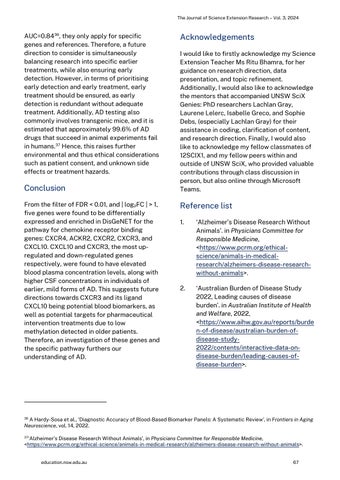The Journal of Science Extension Research – Vol. 3, 2024
AUC=0.84 36, they only apply for specific genes and references. Therefore, a future direction to consider is simultaneously balancing research into specific earlier treatments, while also ensuring early detection. However, in terms of prioritising early detection and early treatment, early treatment should be ensured, as early detection is redundant without adequate treatment. Additionally, AD testing also commonly involves transgenic mice, and it is estimated that approximately 99.6% of AD drugs that succeed in animal experiments fail in humans. 37 Hence, this raises further environmental and thus ethical considerations such as patient consent, and unknown side effects or treatment hazards.
Conclusion From the filter of FDR < 0.01, and | log2FC | > 1, five genes were found to be differentially expressed and enriched in DisGeNET for the pathway for chemokine receptor binding genes: CXCR4, ACKR2, CXCR2, CXCR3, and CXCL10. CXCL10 and CXCR3, the most upregulated and down-regulated genes respectively, were found to have elevated blood plasma concentration levels, along with higher CSF concentrations in individuals of earlier, mild forms of AD. This suggests future directions towards CXCR3 and its ligand CXCL10 being potential blood biomarkers, as well as potential targets for pharmaceutical intervention treatments due to low methylation detected in older patients. Therefore, an investigation of these genes and the specific pathway furthers our understanding of AD.
Acknowledgements I would like to firstly acknowledge my Science Extension Teacher Ms Ritu Bhamra, for her guidance on research direction, data presentation, and topic refinement. Additionally, I would also like to acknowledge the mentors that accompanied UNSW SciX Genies: PhD researchers Lachlan Gray, Laurene Lelerc, Isabelle Greco, and Sophie Debs, (especially Lachlan Gray) for their assistance in coding, clarification of content, and research direction. Finally, I would also like to acknowledge my fellow classmates of 12SCIX1, and my fellow peers within and outside of UNSW SciX, who provided valuable contributions through class discussion in person, but also online through Microsoft Teams.
Reference list 1.
‘Alzheimer’s Disease Research Without Animals’. in Physicians Committee for Responsible Medicine, <https://www.pcrm.org/ethicalscience/animals-in-medicalresearch/alzheimers-disease-researchwithout-animals>.
2.
‘Australian Burden of Disease Study 2022, Leading causes of disease burden’. in Australian Institute of Health and Welfare, 2022, <https://www.aihw.gov.au/reports/burde n-of-disease/australian-burden-ofdisease-study2022/contents/interactive-data-ondisease-burden/leading-causes-ofdisease-burden>.
36 A Hardy-Sosa et al., ‘Diagnostic Accuracy of Blood-Based Biomarker Panels: A Systematic Review’, in Frontiers in Aging Neuroscience, vol. 14, 2022.
‘Alzheimer’s Disease Research Without Animals’, in Physicians Committee for Responsible Medicine, <https://www.pcrm.org/ethical-science/animals-in-medical-research/alzheimers-disease-research-without-animals>. 37
education.nsw.edu.au
67
